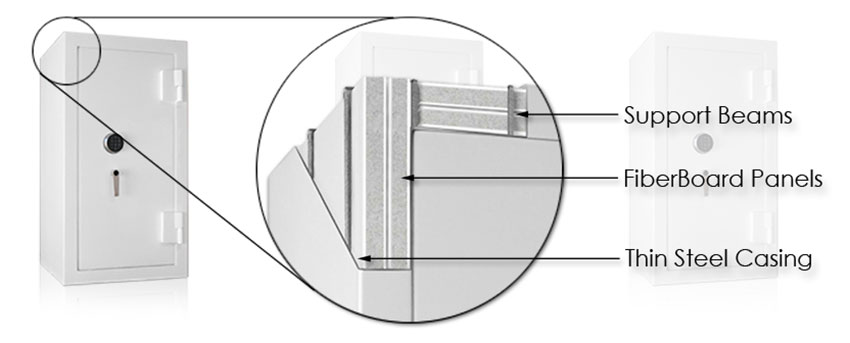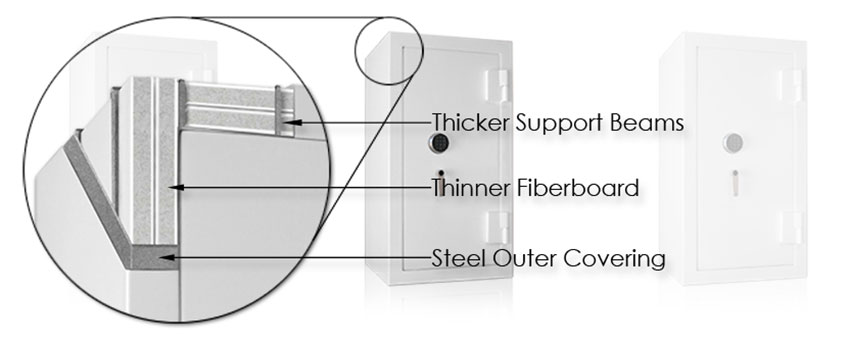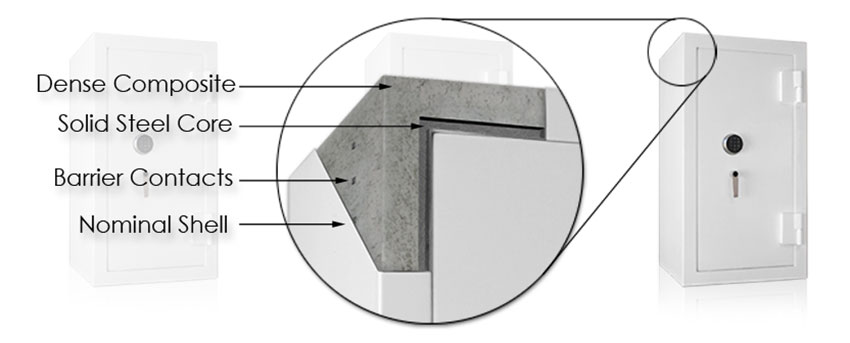
On the surface, each fire safe can look essentially the same. The three safes shown here offer vastly divergent fire and burglary protection, yet it is nearly impossible for a concerned buyer to distinguish the well-constructed fire safe from its neighboring imposters. While the three fire safes pictured below may look identical, only one fire safe provides adequate fire protection.
To reveal the true Fire Safe in this bunch, we must peel away the outer shell exposing the core of each safe's foundation...

Sadly, many of the so-called fire safes available today do very little to adequately protect the contents within from reaching flash point. These widely available fire-resistant security containers are of little value, in fact only serving to provide false hope. All too often the safe appears to have survived the inferno, only to find the items inside are incinerated, smoke-damaged or ruined by the water from the fire hoses.
At Brown Safe we have completely re-examined how conventional fire-resistant safes are built and greatly improved on the standard methods in an effort to best protect your valuables in the event of a fire. Through a thorough assessment of fire-resistant materials, heat conductivity and superior engineering, we have established a new benchmark in fireproof safe design and substantiated ourselves as the top manufacturer of the very best fire safes on the market today.
Our robust home fire safes have withstood tremendous fire storms. We are very proud to have played a part in protecting our client's invaluable items. Read more about these real-world tests here
Which one of these safes can handle the heat?
False Security Safe Construction Ratings
Fireboard based Fire Safe (aka... Drywall Safe, Insulation Fire Safe)
While fireboard safes make up the majority of top-selling safes, these safes are in truth the least effective at fire protection. Fireboard fire safes also provide insignificant burglar protection. The three key points below explain why.


Very similar in composition to household drywall, these lightweight fire-retardant panels, also known as firewall or fiberboard, are placed between the thin outer and inner walls of the safe to act as a heat barrier. While stacking many of these panel does prevent heat passage, excessive heat still passes through the steel support structure holding the panels and inner safe in place.
A common marketing trick used by many fire safe builders is to quote the fire rating of the fireboard the safe uses instead of the safe's actual fire rating ...which is generally much much lower. Many of these safes are never actually tested in a fire.
Another major drawback to fireboard-based safes is that most fiberboard panels contain high levels of moisture. The moisture increases the level of fire protection during a fire but will create a constantly damp environment inside the safe, causing corrosion of metal belongings and wilting of paper-based items.
Fireboard tends to loose its fire resistance over time as the moisture continues to seep out.
During an actual fire, fireboard functions by releasing an excessive amount of moisture as it heats, expelling the built-up heat as steam. But due to the thin, poorly constructed and oftentimes non-existent inner casing ...excessive expelled stem permeates into the safe's interior, subjecting the contents to a heavy moisture environment until the safe is finally opened, usually days later. Oxidation and moisture damage to the safe's contents is common.

Support beams and other foundation structuring in fireboard safes pass heat from the fire safe's exterior right through to the safe's interior, the biggest weakness in this type of fire safe.
Since fireboard itself is incapable of providing any form of support (or protection), fireboard-based safes must reinforce the steel framework of the safe to support the safe's weight. Safes that are designed to survive two story drops have even more reinforcement. This reinforcement takes the form of thick steel supports that run roughly every foot, connecting the inner and outer safe walls with the fireboard panels inserted between. Unfortunately, these same supports act as a direct heat conduit. During a fire, heat bypasses the fireboard through all exposed supports and rapidly moves into the safe's interior, incinerating the safe's contents in short order.

Cost-cutting safe builders will generally cover the safe's exterior in the thinnest sheet metal casing possible, in an effort to keep the safe's already-low fire rating from dropping further.
Why? Because steel absorbs and transfers heat. Also, the thicker the safe's outer steel, the more heat it absorbs and in turn transfers to the safe's interior through the above-mentioned steel support beams. While this wily trick does help in reducing the amount of heat transfer, it also means the safe is left with virtually zero burglary protection.
To sum it up...Thin sheet metal outer shell, to a drywall insulation layer, to a thin sheet metal or wood interior, equals a safe that can be pried open within minutes by an unskilled burglar equipped with an ordinary crowbar.
Overall, a Fireboard-style safe is an inferior fire safe and an inferior burglary safe.
False Security Safe Construction Ratings
Reinforced Fireboard Fire Safe - This is a fireboard-style safe that also affords some
degree of burglar protection. Unfortunately, fire protection and burglar protection run in two divergent directions when using this method of fire safe design. As the thickness of outer steel increases to enhance burglar protection, the safe's ability to withstand fire decreases. The three points below explain why.


A thicker steel outer covering is the key ingredient that distinguishes these fire safes from standard fireboard safes. While the steel does increase overall burglary protection, this same metal rapidly absorbs heat during a fire, cooking the contents within. The fireboard panels do their best to counter the heat assault, but rapidly give in under the extreme direct contact temperatures caused by the metal covering. The thicker the steel, the greater the problem this becomes.

The support beams and foundation structure of a reinforced fire safe must be made of thicker steel to support the dramatic weight increase of the outer steel covering. This increased thickness provides even larger pass-through areas for heat...any heat trickle now becomes a heat flood.

Fireboard Panels tend to be thinner in safes that use thicker outside steel panels, exacerbating all the above-mentioned weaknesses.
Reinforced fireboard safes do provide some degree of burglar protection, but this protection comes at the cost of further reduced fire protection on a safe style that already falls short in this area.
Proper Fire Safes
Brown Safe Composite Fire Cladded Safe - These true fire safes are engineered using a vastly different methodology, one that produces superior results in all important areas. Whereas fireboard safes are designed as inexpensive-to-manufacture fire safes that may receive some upgrade in burglar protection, composite cladded fireproof safes are built from the ground up as high security burglary safes that then undergo a fire cladding process. The four points below detail why this approach produces a superior fire and burglary safe.


The solid steel core of a composite cladded fire safe is an actual burglary safe, one built to any protection rating desired. In harsh contrast, the core of a fireboard safe is comprised only of either thin sheet metal, wood, or sometimes the interior panels are attached directly to the fireboard... providing no true burglar protection.

A dense composite amalgamate is poured around the entire steel core of the safe. The process is similar to that of poured concrete. Once hardened, 2½" of solid composite material encases the entire safe, including a 2" solid filled amalgamate door. Not only is the composite material superior to fireboard for fire protection, the dense composition of this outer amalgamate cladding greatly adds to the safe's already substantial burglary protection.

Barrier contacts are small spot-welded positioning pins that temporarily hold the outer shell of the safe in place while the composite material is poured. Once hardened, the composite material directly supports the safe's weight with no need for a steel foundation or support beams required by fireboard safes. Barrier contacts are the primary means through which outside heat gains entrance into the inner safe walls during a fire, so they are kept small enough to provide a negligible heat pathway.
In contrast, the foundation structure and numerous thick support beams that run between the inner and outer walls of a standard fireboard safe, present gaping contact pathways for fire heat to quickly flood from the exterior into the safes core.

The nominal steel shell of the composite safe is very thin to avoid heat building up on the safe's exterior. This shell is kept thick enough to hold the composite material as it's being poured, and no more. When contrasted with the thick, heat-collecting outer shell of a reinforced firewall safe, the shell of a composite safe produces negligible heat buildup.
The above design methods allows Brown Safe's composite cladded safes to substantially outperform both fireboard and reinforced fireboard safes in both fire and burglary protection. Brown Safe composite cladded fire-resistant safes stand in a league of their own.